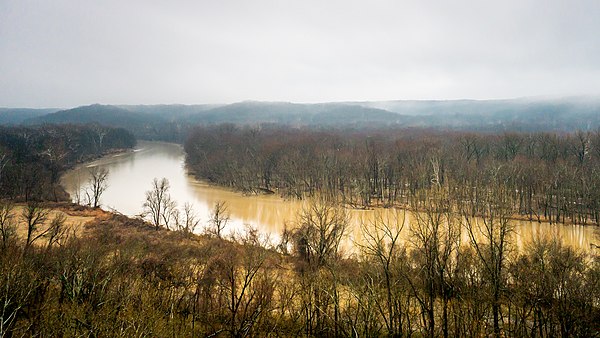The Meramec River is one of the longest free-flowing waterways in the state of Missouri, draining 3,980 square miles over the 218 miles from its headwaters in Salem to where it empties into the Mississippi River south of St. Louis, near Arnold and Kimmswick.
According to Wikipedia ©2019:
History
Today, the river is used commercially by tourboats and sand and gravel mining barges. It also is used by canoe outfitters and ferry boat excursions. Numerous trails travel along the river and up over the bluffs, giving the hiker a glimpse of ducks, herons, beavers and other species of wildlife which may be seen along the river.
Ecology
At one time, the river was listed as one of the most polluted rivers in Missouri. Local and state government along the river have taken tremendous steps in cleaning it up. Today the river is one of the most diverse waters in Missouri. The river is plentiful in black crappie, channel catfish, flathead catfish, largemouth bass, paddlefish, rainbow trout, brown trout, rock bass, smallmouth bass, walleye, white crappie, and some of the richest mussel beds in the state. The endangered Eastern Hellbender (Cryptobranchus alleganiensis alleganiensis) also lives in the river.
The Meramec River includes one of only three Red Ribbon Trout Areas in the state of Missouri, hosting healthy rainbow trout and brown trout populations where large springs flowing into the river provide the cool water required by these species. Red Ribbon trout streams are managed by the Missouri Department of Conservation to produce trophy-sized fish.
Maramec Spring is the fifth-largest spring in Missouri. Maramec Spring Park, south of St. James, is the home of an historic iron works and trout fishery.
Flooding
As a free-flowing river with no flood control dams, the Meramec is subject to flooding. In addition to a flood in December 1982,[3] there was major flooding December 2015 and in May 2017.[4] Only the community of Valley Park, protected by a $50 million levee designed by the U.S. Army Corps of Engineers, was spared.[5] For the first time in state history, MoDOT had to shut down I-55 from flooding in 2015.
Meramec Basin Project
This map shows the extent of the main reservoir that would have been created at Sullivan by the Meramec Basin Project.
The free-flowing Meramec River and several of its tributaries narrowly avoided being impounded by several dams proposed by the Corps of Engineers.[6] The United States Congress authorized several large dams in the upper Mississippi and Meramec river basins in 1938 following severe flooding in 1927 and 1937. World War II intervened, and plans were delayed and altered, but the Meramec Basin Project finally started moving forward in the 1960s. The main dam was to be at Sullivan, Missouri, at Meramec State Park, with several additional dams upstream. These plans ran into opposition from the growing environmental movement of the 1960s and 1970s, as well as from recreational users of the free-flowing Meramec. The failure of the Teton Dam in 1976 increased the public’s doubt about the wisdom of the project.
Grass-roots opposition forced politicians originally in favor of the project to reconsider. At the request of Senators Jack Danforth and Tom Eagleton, Missouri Governor Kit Bond allowed a non-binding referendum to be put on ballots in twelve surrounding counties. On August 8, 1978, 64 percent of the voters rejected the dam proposal. The referendum carried no legal weight but caused Congress to reconsider. Under President Jimmy Carter, funding was removed from the project. In 1981, President Ronald Reagan signed the bill de-authorizing the project. This was one of the first times that a Corps of Engineers project was stopped once construction had begun, and it marked a major victory for the American environmental movement.


